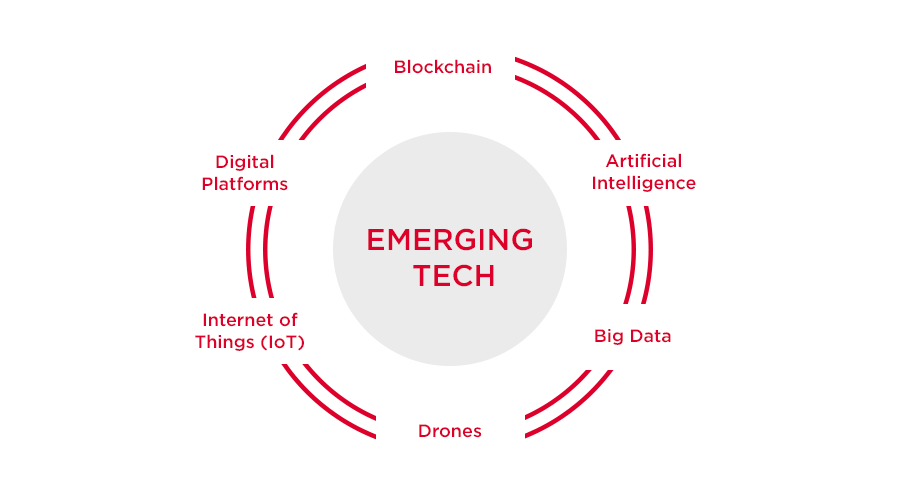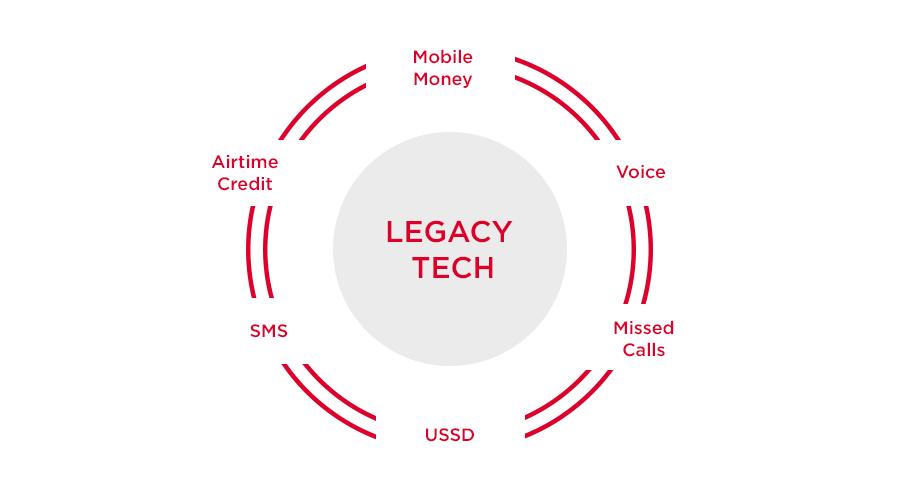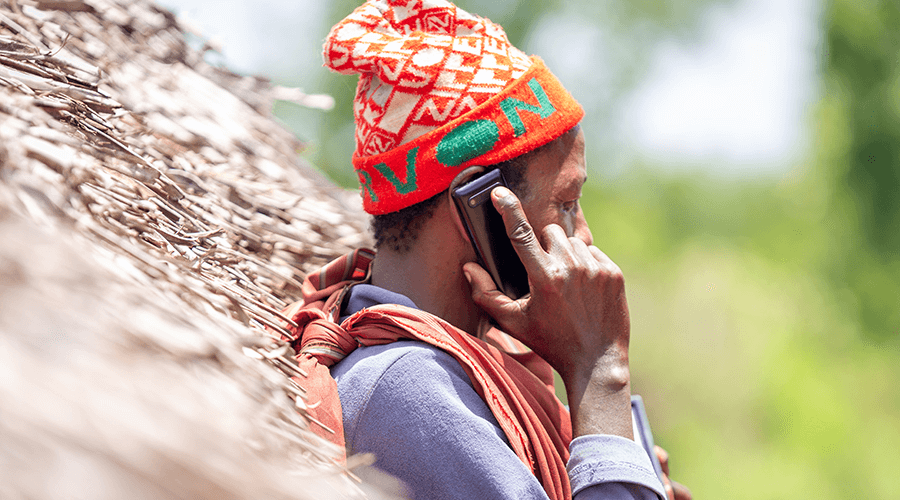This blog series is a collaboration between the GSMA Innovation Fund and Central Insights Unit, who will continue to produce collaborative insights on Emerging Technology.
Mobile technology is the foundation for all the work that GSMA Mobile for Development does to enable sustainable and inclusive development in low- and middle-income countries (LMICs). As part of our work through the Innovation Fund, we support innovative start-ups and social enterprises to develop and scale digital solutions that combine legacy mobile technology, such as USSD, IVR and SMS, with emerging technology, including AI, IoT and blockchain.
Emerging Tech in principle
By harnessing emerging technologies, impact-driven innovators can make significant strides towards addressing socio-economic challenges for people who lack access to basic services.
We define emerging technology as potentially disruptive technologies that can address large-scale challenges or opportunities. This includes but is not limited to Artificial Intelligence (AI), big data, blockchain, the Internet of Things (IoT), digital platforms, and drones.

It is estimated that the implementation of AI can help to advance the 128 of the 169 SDG targets, creating social and economic impact in LMICs where innovative approaches to inclusive sustainable development and bridging inequalities are most needed. IoT solutions also have a role to play in addressing development challenges, such as the potential to improve essential utility services, and reduce global greenhouse gas emissions by 16.5% by 2030, according to the Global e-Sustainability Initiative (GeSI). According to a study by the International Telecommunication Union (ITU), blockchain can address the challenges that arise from rapid urbanisation, as it can help monitor supply chains, execute and validate data trails, and ensure authenticity and integrity of data.

Legacy technologies, such as mobile money, USSD (Unstructured Supplementary Service Data), and SMS (Short Messaging Service), still have an important role to play in addressing social challenges, as feature phones are still in use by 600 million people who lack access to banking and basic services, as of 2023. Legacy mobile technology is still necessary for delivering innovative solutions to millions of people, as it is easily accessible by people with both smartphones and feature phones, thus reaching a wider audience.
Reaching those who are digitally and financially excluded at scale requires easily accessible and cost-effective technologies. Feature phones are simple, cheap and functional, and have a longer lasting battery life, which is important for those living in areas where electricity is inaccessible or unreliable. For this reason, some smartphone users also own basic and features phones. Therefore, innovative start-ups who employ emerging technology should still leverage legacy technology to maximise their impact.

Emerging tech in action
The use of emerging technology is becoming increasingly useful in scaling impactful business models in LMICs, and more innovators are pivoting to business models centred on emerging technology. To reach those who are digitally and financially excluded at scale, digital solutions must be designed with the end user and their mobile device in mind. While emerging technology can drive innovation from the back end, legacy technology is still a useful and effective way to get the innovation into the hands of the user. One such example is Ghanaian start-up BenBen that leverages blockchain and USSD to build digital solutions that promote socioeconomic welfare, land tenure security, and equitable land governance across Africa’s land investment and financing landscape. In collaboration with OKO Forests and the Foreign Commonwealth and Development Office (FCDO), BenBen is exploring the role of blockchain and USSD in protecting smallholder farmer agri-carbon investments in Ghana.
Another example comes from Viamo, a social enterprise that enables organisations to deliver training, digital campaigns, and surveys via voice channels (IVR) in partnership with mobile operators. Viamo recently trialled a generative AI voice-based assistant in Zambia called Ask Viamo Anything, which is accessible on feature phones. Viamo plans to eventually integrate the AI assistant into its main platform. These examples demonstrate the synergy of emerging technology as innovation at the back end of a digital solution, with legacy technology at the front end for service delivery.
The following GSMA Innovation Fund portfolio innovators are combining emerging technology with mobile apps, digital payments and legacy technology to scale their solutions for maximum impact:
| Start-up | Country | Sector | Summary | SDG |
| Orenda | Pakistan | EdTech | Orenda developed an AI system that enables them to automate most of their content creation, creating relevant content more quickly. They received $1 million from the Qatar Foundation, which invested in them specifically because of their new AI technology and the potential to replicate their services in other countries. | 4 – Quality Education |
| Crop2Cash | Nigeria | AgriTech | Crop2Cash is developing an AI-powered system to provide personalised, real-time agricultural advice to smallholder farmers in their local language. This is expected to help farmers strengthen their resilience to climate change. Crop2Cash then uses USSD to give their smallholder farmers access to advisory services, an inclusive marketplace, and support in multiple languages. | 13 – Climate Action |
| ATEC | Bangladesh | ClimateTech | ATEC’s eCook is an IoT-enabled stove that allows users to monitor their energy consumption, pay for their stove via mobile money and earn carbon credits by switching from polluting fuels. Their PAYGO payment system uses SMS and USSD for payments and registration of their e-Cook stoves. | 7 – Affordable and Clean Energy |
| Aquarech | Kenya | AgriTech, ClimateTech | Aquarech offers an IoT solution for fish farmers to check water temperature in real time. This is complemented by a USSD platform that they can use to purchase fish feed and access aquaculture tips. | 8 – Decent Work and Economic Growth |
| J-Palm Liberia | Liberia | AgriTech, ClimateTech | J-Palm Liberia uses two mobile blockchain apps to create transparent and traceable supply chains for Liberia’s wild harvest palm oil, which will ultimately expand market access for thousands of smallholder oil palm farmers in Liberia. | 13 – Climate Action |
| Dayaxa | Ethiopia | AgriTech, ClimateTech | Dayaxa uses blockchain to be transparent about where and how they source their frankincense. It does this through an incorruptible platform where they document all their practices, including the origin and movement of resin, sustainable harvesting and ecosystem management and fair payments to harvesters. | 8 – Decent Work and Economic Growth |
Looking ahead: a call to support emerging tech in LMICs
Leveraging emerging technologies for sustainable and inclusive development requires exploring opportunities to enable more intelligent, data-driven solutions. This will contribute to increasing digital and financial inclusion through greater access and adoption of the mobile internet, including reducing the gender gap for women and the disability gap.
Advancing the use of mobile and digital technologies will also support climate change mitigation, adaptation and resilience strategies, the digitisation of agricultural value chains, unlocking access to affordable and improved energy, water and sanitation services, as well as ensuring effective humanitarian assistance through digital channels.
The GSMA Innovation Fund calls on private and public funders, as well as mobile operators in emerging markets, to support local innovators (start-ups and SMEs) to reach sustainability and maximise impact using emerging technologies.
Our recent Impact Portfolio provides evidence that philanthropic capital can have a catalytic effect to de-risk innovation. Further investment from the private sector and more strategic partnerships are needed to sustain this impact through increased market penetration and replication.
Keep an eye out for our upcoming spotlights on the implementation of Emerging Tech for sustainable development as we continue looking at relevant use cases.
The GSMA Innovation fund is currently funded by UK international development from the UK government and the Swedish International Development Cooperation Agency (Sida); and our Central Insights Unit programme is currently funded by UK International Development from the UK government and is supported by the GSMA and its members.



